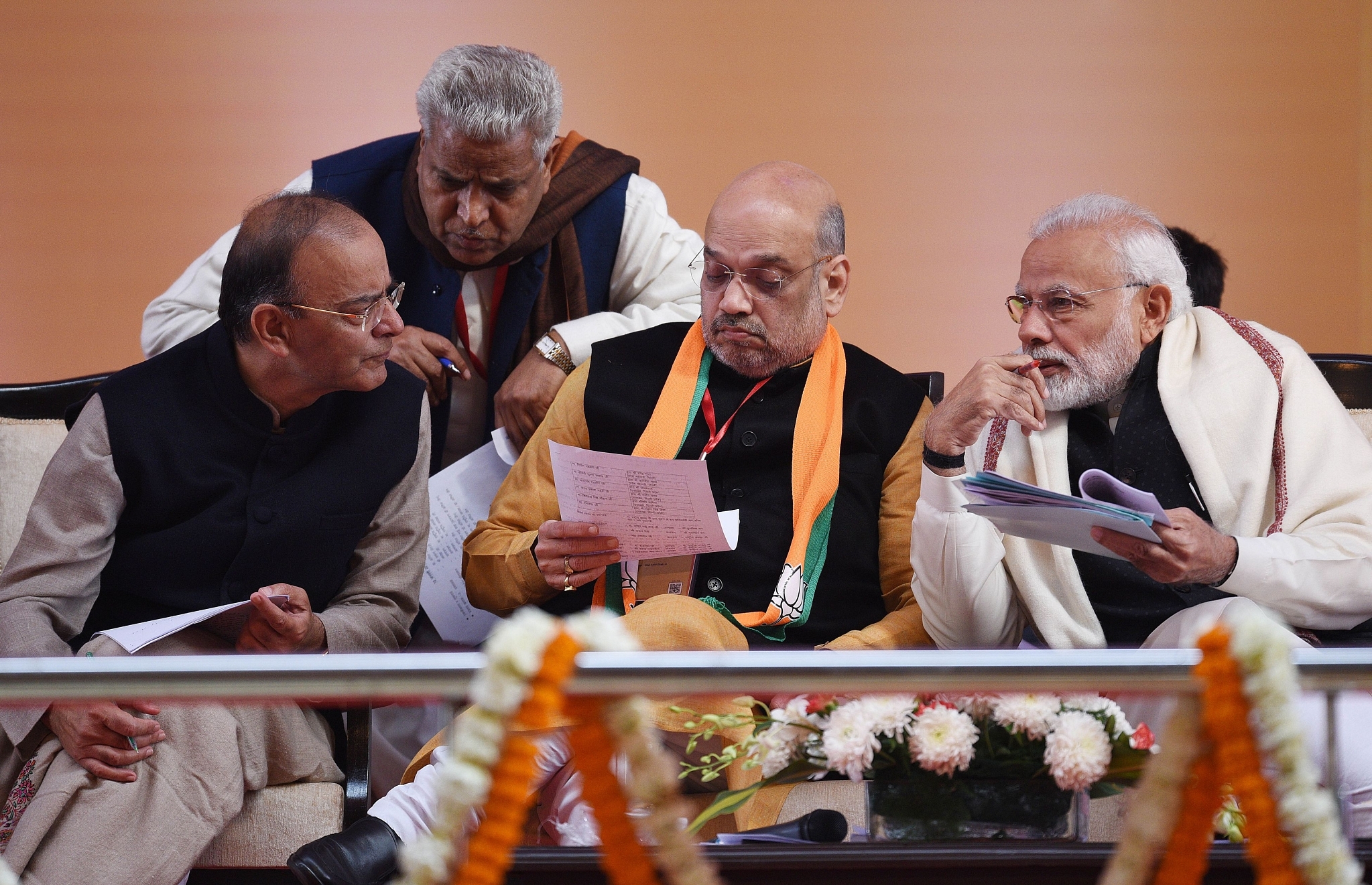Politics
Why The BJP Would Be Foolish To Wait For A Rajya Sabha Majority To Push Difficult Reforms
- A Rajya Sabha majority is worth hoping for, but working for a consensus on big ticket reforms now is a more sensible goal to work for.
- In any case, an NDA majority is not the same as a BJP majority in the Rajya Sabha. Modi can influence the former, but not always the latter.

Prime Minister Narendra Modi, BJP president Amit Shah and Finance Minister Arun Jaitley at a BJP meeting. (Pankaj Nangia/India Today Group/Getty Images)
The BJP-led NDA is hoping to gain a Rajya Sabha majority by end-November 2020 (123 is the mid-point in an effective strength of 245), which will help it push key reform bills in its second term.
While a Rajya Sabha majority may be desirable for any party that wants to pass major economic and social legislation, it makes little sense to wait another year-and-a-half for that happy outcome, when there are a whole lot of state elections intervening. It would be more sensible for the BJP to get its existing allies and some opposition parties to back its bills now, possibly in return for some political quid pro quo, rather than wait for the end of next year.
In its first term, a lot of critical reforms, like the Insolvency and Bankruptcy Code and the goods and services tax, got shifted to the second half, thus making it impossible to show the benefits to voters ahead of the general elections. Narendra Modi cannot afford to backload important reforms to the second half of his second term.
The problem with waiting till end-2020 for a Rajya Sabha majority, and that too for the NDA, is dicey for the NDA is not some fixed entity whose allies can be taken for granted.
In the case of the Citizenship Amendment Bill, for example, both the Shiv Sena and the Janata Dal (United) were officially opposed to it. The NDA, which has 102 MPs in the Rajya Sabha today, includes the BJP’s 73, and 13 of the AIADMK, which got a walloping in the recent Lok Sabha election in Tamil Nadu. The AIADMK’s ability to retain power in the state assembly may depend on occasionally opposing the BJP in order to impress the minorities in the state. Any Tamil party that is too cosy with the BJP risks eroding its local support base. So, to count the AIADMK’s MPs as some kind of given in the NDA total is optimistic, to say the least.
On the other hand, the expectation that the BJP will make huge gains this year and the next in the Rajya Sabha assumes that it will retain its assembly numbers in Maharashtra, Haryana and Jharkhand elections later this year.
The BJP lost some of its edge when it was defeated (though narrowly in two states) in Madhya Pradesh, Chhattisgarh and Rajasthan last year. Its big hopes rest on the Uttar Pradesh Rajya Sabha numbers next year, when 10 seats fall vacant.
Given the uncertain nature of state politics, and given the short time at its disposal to deliver results, the BJP would be unwise to wait for a Rajya Sabha majority of its own in order to push big reforms. Those reforms, whether on land or labour or agriculture, are needed now, and not after 18 months. It should work for the best deal with allies and opposition parties now, when both will have some measure of fear and willingness to cooperate after Modi’s thumping win on 23 May, not later, when the honeymoon period has ended.
As and when the NDA gets its own majority, it can obviously improve on the reforms later. Half a loaf now is better than no loaf at all.
A Rajya Sabha majority is worth hoping for, but working for a consensus on big ticket reforms now is a more sensible goal to work for. In any case, an NDA majority is not the same as a BJP majority in the Rajya Sabha. Modi can influence the former, but not always the latter.
Support Swarajya's 50 Ground Reports Project & Sponsor A Story
Every general election Swarajya does a 50 ground reports project.
Aimed only at serious readers and those who appreciate the nuances of political undercurrents, the project provides a sense of India's electoral landscape. As you know, these reports are produced after considerable investment of travel, time and effort on the ground.
This time too we've kicked off the project in style and have covered over 30 constituencies already. If you're someone who appreciates such work and have enjoyed our coverage please consider sponsoring a ground report for just Rs 2999 to Rs 19,999 - it goes a long way in helping us produce more quality reportage.
You can also back this project by becoming a subscriber for as little as Rs 999 - so do click on this links and choose a plan that suits you and back us.
Click below to contribute.
Latest